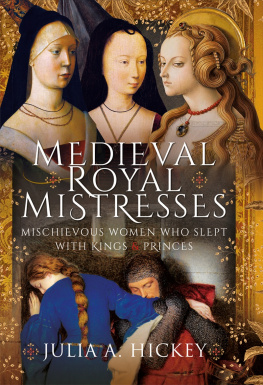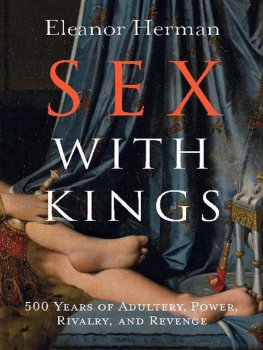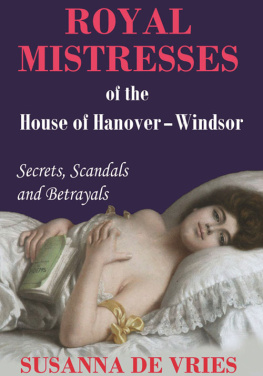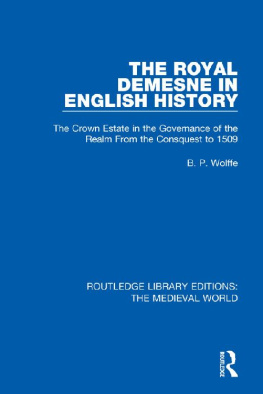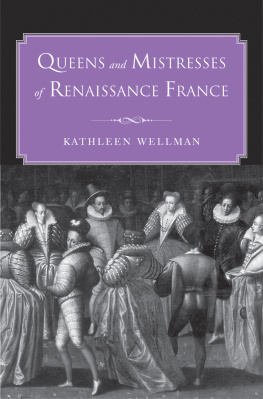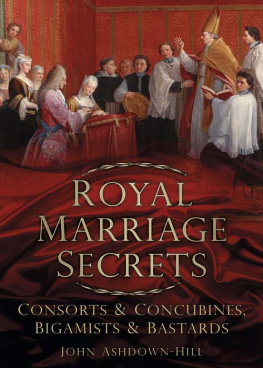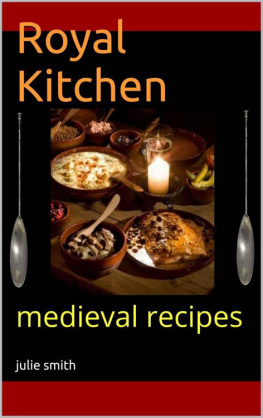Pagebreaks of the print version

Medieval Royal Mistresses
Front cover: Hellelil and Hildedbrand, the Meeting on the Turret Stairs by Frederic William Burton, (watercolour and gouache on paper, 1864) NGI.2358, bequeathed, Miss Margaret Stokes, 1900. ( National Gallery of Ireland )
Medieval Royal Mistresses
Mischievous Women who
Slept with Kings and Princes
Julia A. Hickey
First published in Great Britain in 2022 by
Pen & Sword History
An imprint of
Pen & Sword Books Ltd
Yorkshire Philadelphia
Copyright Julia A. Hickey 2022
ISBN 978 1 39908 194 8
EPUB ISBN 978 1 39908 195 5
MOBI ISBN 978 1 39908 195 5
The right of Julia A. Hickey to be identified as Author of this work has been asserted by her in accordance with the Copyright, Designs and Patents Act 1988.
A CIP catalogue record for this book is available from the British Library.
All rights reserved. No part of this book may be reproduced or transmitted in any form or by any means, electronic or mechanical including photocopying, recording or by any information storage and retrieval system, without permission from the Publisher in writing.
Pen & Sword Books Limited incorporates the imprints of Atlas, Archaeology, Aviation, Discovery, Family History, Fiction, History, Maritime, Military, Military Classics, Politics, Select, Transport, True Crime, Air World, Frontline Publishing, Leo Cooper, Remember When, Seaforth Publishing, The Praetorian Press, Wharncliffe Local History, Wharncliffe Transport, Wharncliffe True Crime and White Owl.
For a complete list of Pen & Sword titles please contact
PEN & SWORD BOOKS LIMITED
47 Church Street, Barnsley, South Yorkshire, S70 2AS, England
E-mail:
Website: www.pen-and-sword.co.uk
Or
PEN AND SWORD BOOKS
1950 Lawrence Rd, Havertown, PA 19083, USA
E-mail:
Website: www.penandswordbooks.com
Illustrations
Authors Note
A print depicting the ill-fated lovers Hellelil and Hildebrand by Frederic William Burton hangs in my study. It depicts the romance of a princess and her body guard. The ballad is the product of a darker side of medieval love and chivalry that also includes Malorys Morte DArthur . Chivalric values produced a medieval culture of courtly behaviour. The literature of medieval romance with love at its heart flourished. But the love was unattainable or lost and the focus was usually upon the chivalric knight rather than his idealised lady. Knights did not expect to win their ladies but romantic love had been given an identity. I grew up reading Jean Plaidy, Dorothy Dunnett and Anya Seton. Katherine , first published in 1954 has never been out of print since. It tells the story of Katherine Swynford, the mistress and third wife of John of Gaunt and unlike the story of Hellelil, it provides a satisfying story of romance, passion and a happy-ever-after. I re-read it during the first lockdown of 2020. Seton researched her book with attention to detail and remained within the constraints of documentary evidence. The facts became part of an absorbing story. However, the relationships and characters depicted in the novel are fiction based on supposition and conjecture. History cannot know the emotions of medieval princes or the women they took to their beds. It cannot know for sure when Lancaster first became attracted to his childrens governess, the way in which the relationship evolved or Katherines feelings. We do not even know for certain what she might have looked like. We might want to know about the depth of the relationships that developed behind the bed curtains and to empathise with the men and women whose lives are uncovered in the primary sources but the historical record is silent on the topic of what royal mistresses thought and felt. Peoples emotions have not changed across the centuries but personal happiness was not always a priority. A writer of historical fiction can fill the gaps between facts, human motives and passion in a way that a writer of non-fiction cannot. However, within these constraints, the history of the medieval royal mistress is significant and one to which popular culture keeps returning.
Introduction
T his book is about some of the temptresses, Jezebels, harlots and repentant Mary Magdalens who slept with medieval kings and princes. The chronicles recount dramas and scandals surrounding beautiful women, and in the case of Edward II, handsome men. Whether mistresses were involved in a lengthy love affair; were innocents seduced and then discarded or were calculating courtesans willing to break the social rules, fiction imagines beautiful women dressed in silks and satins, the distant sound of ballads being played on the lute and soft throaty laughter as well as the occasional ripped bodice. However, history was written by monastic chroniclers of the medieval era, with their own agenda of Hell, repentance and salvation, depicted temptation, sin and debauchery drawing on the models of Eve, Jezebel and the Whore of Babylon. Also, later writers added to the stories which usually reflected the concerns of the day. And the reality? Rather than a spotlight played on desirable women its more a case of find the lady amidst charters, pipe rolls and legal documents in the hope that the echoes of the women who gave birth to countless royal bastards might be amplified. Most of the women, deemed unimportant at the time, have been erased from the written record and effectively silenced.
The choice of dates is pragmatic from 1000 to 1485 and the ascent of Henry Tudor to the throne, a Beaufort descendant of Katherine Swynford. The Norman Conquest of 1066 is a key date in English history, its certainly the best remembered. However, whilst the Saxon elite may have suffered a discontinuity in the political upheaval that followed, it is equally important to consider some of the cultural patterns that evolved more slowly. Marriage was an essential part of the dynamics of royalty before 1066 just as it was afterwards but the Church had not yet completely transformed itself into the arbiter of what constituted legal marriage. William of Jumiges writing the Deeds of the Dukes of Normandy in the mid-eleventh century described two forms of marriage; . Both the Danish and the Christian forms of marriage were legal, a reminder that England was multi-cultural and there was coexistence rather than a single homogeneous nation. Kings and earls, eager for alliances and political gain, were able to take advantage of making more than one kind of marriage whilst the definition of a legal union remained unfocused. A century later, Church marriage was the only recognised form of union in England, and even then, a textbook of canon law known as the Decretum described concubinage combined with marital affection as a form of sanctioned union. The stories of women like lfgifu of Northampton and Edith Swanneck, eleventh-century women who married outside the Church, were written or even rewritten by monastic chroniclers with an interest in emphasising the sinfulness of women who indulged in sex outside the confines of a Church-sanctioned union. They were transformed into concubines or mistresses who were morally weaker than the men around them but who tempted kings like Cnut the Great and Harold Godwinson. William the Conquerors contemporaries were more careful about the way they depicted his mother, Herleva, as they had no wish to rouse his anger. Her story became interwoven with her destiny as the mother of powerful kings but even Duke Robert I repented of his youthful indiscretions and set William the Conquerors mother to one side.

